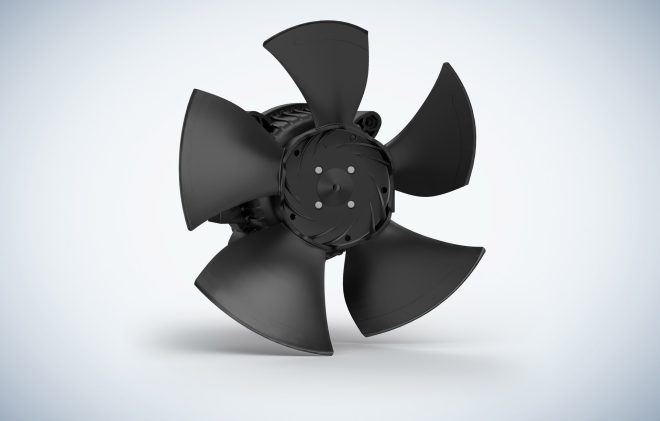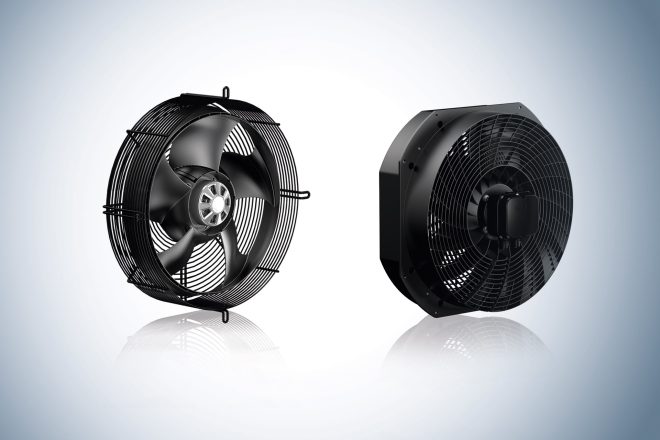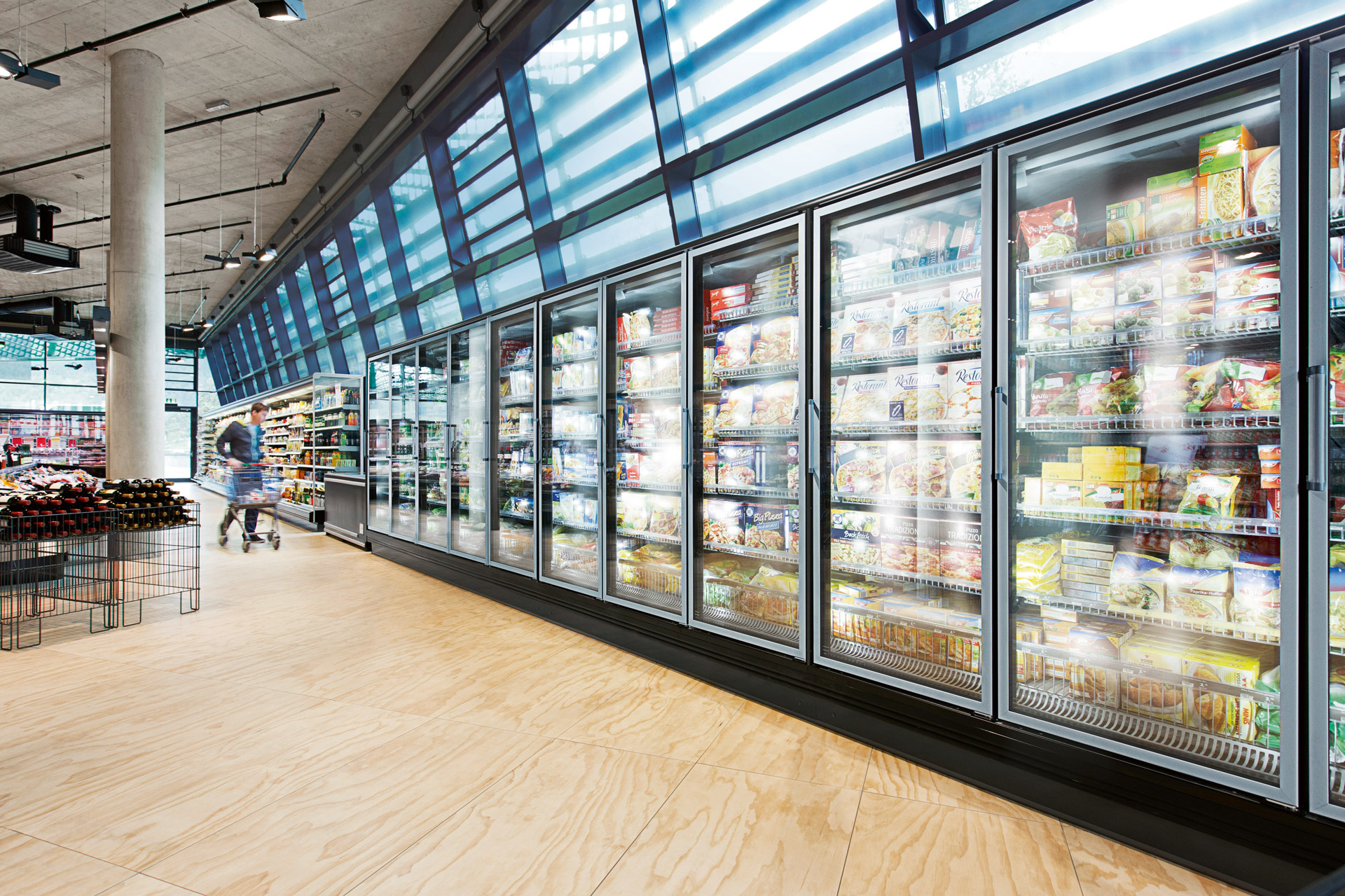Until a few years ago, AC asynchronous and shaded-pole motors were usually used as standard for fan drives in refrigeration technology. There were good reasons for this: Both are cheap to produce, robust and durable. However, their low efficiency levels of only 30% are no longer acceptable today. Their current consumption is high and they also generate waste heat that has to be dissipated. And so the use of AC motors is now restricted to just a few niche applications.
Simple replacement for greater efficiency in refrigerated cabinets
Given the energy savings that can be achieved, it is even well worth converting older refrigerated cabinets and display cases. In addition to the energy-saving fans already established on the market with GreenTech EC technology for refrigeration technology, one of the solutions ebm-papst has developed is the iQ-one EC motor (Fig. 1), which enables easy one-for-one replacement of existing Q or shaded-pole motors with an output power of up to 5 watts. Compared to conventional Q motors, it operates with a significantly higher efficiency of up to 50% and is extremely quiet, even at full power. With its wide voltage input of 100-240 VAC, it can be used worldwide.

The iQ-one can be combined with different fan impellers in sizes 154, 172 and 200 mm. The aerodynamically optimized plastic impellers in sizes 172 and 200 mm in particular creates an efficient fan solution for many applications. As standard, the new motor meets the European standards EN 60335-2-24 (Household appliance standard – Particular requirements for refrigerating appliances, ice-cream appliances and ice makers) and EN 60335-2-89 (Household appliance standard – Particular requirements for commercial refrigerating appliances and ice-makers) and is therefore suitable for today’s natural and flammable refrigerants.
Energy efficiency in refrigerated display cases
Even more energy can be saved in refrigerated display cases with EC motors from the ESM series. They operate at efficiency levels of over 70% at just 10 % of the power consumption of comparable shaded-pole motors and offer demand-based speed control and networking options. The compact EC motors are available as a complete plug-and-play system with fan impeller and fan housing, with the individual components perfectly coordinated with one another. Examples include the energy-saving fans W1G 200 and K1G 200.
The W1G axial product range is intended for installation in refrigerated display cases below the lowest display. By contrast, the K1G product range with diagonal compact fan impeller was specially designed for the rear wall of refrigerated display cases, where there is often limited installation space (Fig. 2). Thanks to their very flat design, these fans fit in confined spaces and the diagonal compact fan design makes them well equipped to deal with the higher back pressure encountered in such situations.

Robust and ATEX-certified
The AxiACi series offers a wide range of applications for compact areas. AxiACi 92 and AxiACi 120 are used in commercial refrigerated cabinets in particular, e.g. in service counters in supermarkets (Fig. 3). The two EC axial fans are now demonstrating their high flexibility and efficiency in switch cabinet cooling applications, as well as in industry and telecommunications. Refrigerated cabinet manufacturers benefit from their potential operating temperatures down to -40°C (including when starting up), DIN EN 60335-2-89 approval, ATEX certification (DIN EN 60079-7 (Group 2A, T4)), and resistance to salt spray, water jets or dust (IP65).

The EC motor, electronics and aerodynamic components are perfectly co-ordinated and have a much lower power consumption than comparable AC fans at the same air flow; in size 92, for example, it is up to 83% lower. Thanks to their low energy consumption, it usually pays for itself after months rather than years, and even earlier while electricity prices are rising. The compact fans are also extremely quiet and are suitable for international use thanks to their broad voltage input.
Less ice formation in cold stores
Today, fans with AC motors are still often used in supermarket cold stores. The solution is cost-effective and usually does not require any speed control. However, the poor efficiency levels are noticeable in the energy costs and waste heat must also be dissipated.
This is why EC fans are worth it here too. Therefore, AxiEco fans can be a good alternative for cold stores like this. Both AxiEco fans with EC technology, available in the two variants AxiEco Protect and AxiEco Perform (Fig. 4), offer a high level of pressure stability at the same time as a high efficiency. The air performance curve has a much steeper slope than with comparable axial fans. Therefore, the fans operate at a high efficiency even with increasing back pressure (Fig. 5).

With many practical design details, the AxiEco Protect series with guard grill has been optimized for ventilation, refrigeration and air conditioning applications. Evaporators simplify service work and compliance with hygiene regulations, for example. The new flow profile without return flow means that the guard grill does not ice up so quickly.

Drainage channels on the fan blades ensure that, after routine defrosting, melt water can easily drain towards the drip pan provided at the evaporator. This prevents the fan blades from freezing up. At the same time, water is prevented from splashing when the fan is restarted. The more stringent the hygiene requirements, the more important this feature becomes.
By contrast, the AxiEco Perform fan with housing is recommended when a ready-to-install fan is required. As a compact plug and play solution with CE marking, the fans are particularly easy to integrate into applications. Users will not have to worry about nozzles or distance from the impeller, nor concern themselves with conducting their own ErP assessment.

The fan also features an aerodynamically optimized housing with integrated guard grill and guide blades. Cavities in the housing corners improve the flow; the guide blades ensure that the swirl in the outlet of the fan, and thus the dynamic losses, are reduced to a minimum. The air throw is also greater than conventional axial fans. This enables an even distribution of cold air in large refrigerated warehouses for example, often meaning that fewer fans are required. Therefore, large cold storage facilities and halls are typical areas where the energy-efficient AxiEco Perform fans are used (Fig. 6).
Digitalization in cold storage facilities

In addition to the lowest possible energy consumption, reliability is also an important topic in cold storage facilities. If a fan fails, it is important to localize and rectify the fault quickly without any adverse effect on the cooling chain and before any food perishes. Preventive maintenance and fan monitoring are also useful. Here, it helps to network the fans with the ebm-papst IntelliGate gateways via the integrated serial MODBUS RTU interface. This enables numerous monitoring and control functions to be executed in real time via remote monitoring from the epCloud (Fig. 7).
By evaluating the internal motor data, valuable information can be provided about predictive and preventive maintenance measures, and the motor concerned can also be easily localized if a service is required. Networking via the communication bus enables fast adaptation to changing operating conditions. After defrosting cycles or if larger quantities can be stored, in combination with external sensors or data from the building control system, the required cooling temperature can be reached more quickly by increasing the fan speed. This demand-based closed-loop control opens up further energy-saving potential.

Leave a comment